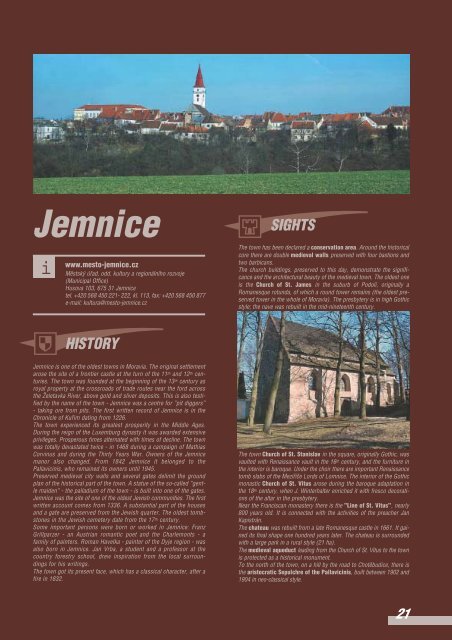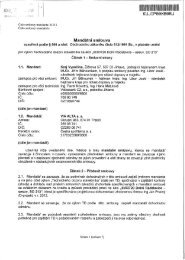history - Extranet
history - Extranet
history - Extranet
- No tags were found...
You also want an ePaper? Increase the reach of your titles
YUMPU automatically turns print PDFs into web optimized ePapers that Google loves.
JemniceSIGHTSiwww.mesto-jemnice.czMûstsk˘ úfiad, odd. kultury a regionálního rozvoje(Municipal Office)Husova 103, 675 31 Jemnicetel. +420 568 450 221- 222, kl. 113, fax: +420 568 450 877e-mail: kultura@mesto-jemnice.czThe town has been declared a conservation area. Around the historicalcore there are double medieval walls preserved with four bastions andtwo barbicans.The church buildings, preserved to this day, demonstrate the significanceand the architectural beauty of the medieval town. The oldest oneis the Church of St. James in the suburb of Podolí, originally aRomanesque rotunda, of which a round tower remains (the oldest preservedtower in the whole of Moravia). The presbytery is in high Gothicstyle; the nave was rebuilt in the mid-nineteenth century.HISTORYJemnice is one of the oldest towns in Moravia. The original settlementarose the site of a frontier castle at the turn of the 11 th and 12 th centuries.The town was founded at the beginning of the 13 th century asroyal property at the crossroads of trade routes near the ford acrossthe Îeletavka River, above gold and sliver deposits. This is also testifiedby the name of the town - Jemnice was a centre for ”pit diggers”- taking ore from pits. The first written record of Jemnice is in theChronicle of Kufiim dating from 1226.The town experienced its greatest prosperity in the Middle Ages.During the reign of the Luxemburg dynasty it was awarded extensiveprivileges. Prosperous times alternated with times of decline. The townwas totally devastated twice - in 1468 during a campaign of MathiasCorvinus and during the Thirty Years War. Owners of the Jemnicemanor also changed. From 1842 Jemnice it belonged to thePallavicinis, who remained its owners until 1945.Preserved medieval city walls and several gates delimit the groundplan of the historical part of the town. A statue of the so-called ”gentlemaiden” - the palladium of the town - is built into one of the gates.Jemnice was the site of one of the oldest Jewish communities. The firstwritten account comes from 1336. A substantial part of the housesand a gate are preserved from the Jewish quarter. The oldest tombstonesin the Jewish cemetery date from the 17 th century.Some important persons were born or worked in Jemnice: FranzGrillparzer - an Austrian romantic poet and the Charlemonts - afamily of painters. Roman Havelka - painter of the Dyje region - wasalso born in Jemnice. Jan Vrba, a student and a professor at thecountry forestry school, drew inspiration from the local surroundingsfor his writings.The town got its present face, which has a classical character, after afire in 1832.The town Church of St. Stanislav in the square, originally Gothic, wasvaulted with Renaissance vault in the 16 th century, and the furniture inthe interior is baroque. Under the choir there are important Renaissancetomb slabs of the Mezifiíãe Lords of Lomnice. The interior of the Gothicmonastic Church of St. Vitus arose during the baroque adaptation inthe 18 th century, when J. Winterhalter enriched it with fresco decorationsof the altar in the presbytery.Near the Franciscan monastery there is the ”Line of St. Vitus”, nearly800 years old. It is connected with the activities of the preacher JanKapistrán.The chateau was rebuilt from a late Romanesque castle in 1661. It gainedits final shape one hundred years later. The chateau is surroundedwith a large park in a rural style (21 ha).The medieval aqueduct leading from the Church of St. Vitus to the townis protected as a historical monument.To the north of the town, on a hill by the road to Chotûbudice, there isthe aristocratic Sepulchre of the Pallavicinis, built between 1902 and1904 in neo-classical style.21
















